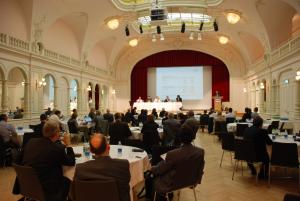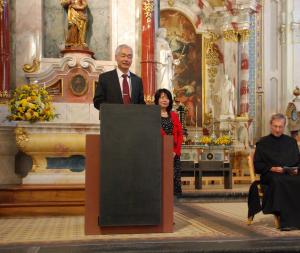The ITER Project at Forum Engelberg
10 Sep 2012
-
Sabina Griffith
Celebrating its 20th edition the Forum Engelberg, a famous encounter of science and spirituality, last week looked at "tomorrow's energy challenges"—a topic of "utmost importance," as Abbot Berchtold Mueller stated in his opening address held at the ancient abbey of Engelberg. For three days this idyllic Swiss mountain village was the picturesque backdrop for scientists, politicians, economists and clerics presenting and discussing various energy technologies, amongst them nuclear fusion.
Nestled in the spectacular snow-capped mountain ranges of central Switzerland, Engelberg has been a famous holiday destination for the rich and famous long before places like St. Moritz and Zermatt appeared on the tourists' radar screens.
ITER-Director Osamu Motojima and his wife during the opening ceremony at the Engelberg Abbey. To their right: Abbot Berchtold Mueller.
The organizers of the Forum Engelberg proudly pointed out that the conference's location, the ornate "Kursaal," was opened in 1902 "at a time when Zermatt didn't even have a sewage system."
But the fame of this remote mountain village dates back much further. It is closely related to the Benedictine abbey founded in 1120 which has perpetually been engaged in political and scientific debates. When, in 1989, the idea came up to find a philosophical equivalent to the big science of the Large Electron Positron Collider (LEP), then the largest particle accelerator which had just been switched on at CERN, the location for this event was soon found.
With energy challenges being the focus of the 20th Forum—and with representatives from the solar, hydro, wind and nuclear industries and from the European Commission gathered once more in the "Kursaal,"—it was ITER Director-General Osamu Motojima who presented the ITER Project and the quest to develop fusion energy.



